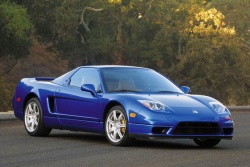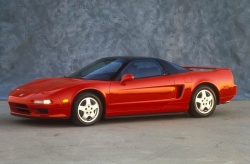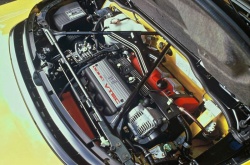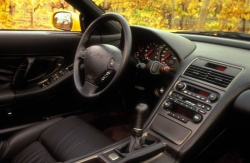 2002 Acura NSX; photo courtesy Honda/Acura. Click image to enlarge |
By Jeff Burry
Find this vehicle in Autos’s Classified Ads
Photo Gallery:
Acura NSX, 1990-2005
Few mainstream automotive manufacturers have attempted to take on exotic car manufacturers, but Honda did just that with the mid-engined NSX in 1990. Dubbed the Ferrari killer, the NSX offered its owners a refined, reliable (not a word usually associated with exotic automobiles) and performance-oriented ride, gift-wrapped in an exotic car skin. The Ferrari 348 was actually Honda’s performance benchmark, as it set out to produce a vehicle unlike anything it had manufactured in previous years.
 1991 Acura NSX; photo courtesy Honda/Acura. Click image to enlarge |
The NSX was also designed to showcase some of Honda’s most advanced automotive innovations and race-car engineering pedigree. The NSX, for example, was the first production vehicle featuring an all-aluminum chassis and suspension, which shaved nearly 200 kilograms off the total weight of the car. The all-aluminum lightweight chassis enabled the NSX to cover 0 – 100 km/h in just over five seconds.
Other revolutionary enhancements included a transversely-mounted (mid-engine) 3.0-litre V6 with dual overhead cams and Honda’s famous VTEC (variable valve timing) system. The all-aluminum chassis featured a fully independent four-channel anti-lock braking system, titanium connecting rods, torque-sensing differential, twin-plate clutch and an electric power steering system, also the first of its type ever utilized within a production vehicle.
The NSX first went on sale in Japan in 1990 under the Honda moniker and was sold in North America under Honda’s Acura luxury division. Canadians, along with our friends south of the border would come to know the vehicle as the Acura NSX. The NSX’s 3.0-litre engine produced a very respectable 270 horsepower (remember, this was the early 1990’s) and the powerplant was stuffed between the fenders of a vehicle which weighed only 1,340 kg (2,950 lbs) dripping wet.
 1997 Acura NSX-T; photo courtesy Honda/Acura. Click image to enlarge |
For those of you who may be thinking that the NSX is all looks with little performance, stand corrected. Honda’s experience and success within Formula 1 played a huge role in the final design and ultimately led to the creation of a true exotic car.
Respected Japanese Formula One driver, Satori Nakajima, performed many of the early endurance track laps providing feedback to the Honda engineers on its performance and handling characteristics. Famous Brazilian Formula One driver, the late Ayrton Senna, was also involved in testing the early models and apparently was able to convince Honda to further stiffen the chassis.
The NSX was sold from 1990 (in Japan) to 2005 and underwent various minor modifications over its life span. For a fifteen-year production run, this was a rare occurrence and perhaps spoke to how Honda “got it right” the first time. Outside of the rather lofty purchase price (just under $100,000, but still well below what one would pay for a true exotic), the NSX was known for its reliability, refinement and sleek “exotic-car” looks.
 1997 Acura NSX; photo courtesy Honda/Acura. Click image to enlarge |
From 1991 through to 1994 few things were tweaked on the Acura NSX. Individuals could choose from either a four-speed automatic or a five speed manual transmission. The tires grew slightly during that period, and potential buyers in 1994 had the option of choosing a tan interior. Previous to the 1994 model year, all NSXs came with either a black or ivory interior.
For the 1995 model year, Honda only produced the NSX-T (T for targa) version, which sported a removable roof panel that could be stored behind the seats. The fixed-roof coupe returned for 1996, joining the targa version; the NSX-T cost consumers an additional $4,000 for that “wind in your hair” driving experience.







 Follow Autos on Twitter
Follow Autos on Twitter



